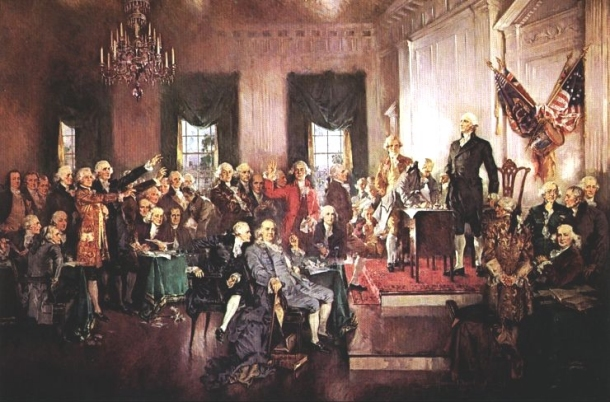This idea came from the this thread: https://www.alternatehistory.com/fo...ired-early-usa-question.396915/#post-13020256
Point of Divergence:
Alexander Hamilton arrived in Boston in 1772. He would go on to join the intellectual elite of the city, becoming a student of people such as Samuel Adams and John Adams. This helped shape his worldview, making him a fiery speaker and, eventually, an avid Revolutionary and Federalist. He would go on to become a close friend of George Washington and serve alongside him during the Revolutionary War. His most lasting impact was the famous Federalist Papers, which would circulate around Massachusetts in the lead up to the Constitutional Convention of 1787.
Table of Contents:
Part I: The Constitutional Convention of 1787 and the Aftermath
Part II: The two Presidents of the United States
Part III: The Whiskey Rebellion
Part IV: A Federal(ist) Response
Part V: A Crisis of Statehood
Part VI: The New Foreign Policy
Part VII: The War that was Promised
Part VIII: The New Commander-in-Chief and the Second Declaration of Independence
Interlude I: Division of American Territories and the First Look Around the World
Part IX: The Changing Tide
Interlude II: The Irish War of Independence
Part X: The Fall of Aaron Burr and the Rise of Dearborn
Interlude III: The French Civil War
Part XI: The Reluctant Federalist and the Decade of Reform
Part XII: The Haitian Revolt
Part XIII: The Mississippi States and Latin Kingdoms
Part XIV: The Monroe Presidency and the American Doctrine
Interlude IV: British Troubles
Part XV: The Rise of the Republicans
Interlude V: The Latin Republics and the Republican Coalition Overview
Part XVI: Internal Affairs
Part XVII: The Truest Patriots
Interlude VI: Rhineland Strong
Interlude VII: Ideologies of the West
Part XVIII: The President Who Was Never Meant to Be
Part XIX: "Quite shocking indeed" - Henry Clay
Part XX: Crimson Cahokia (coming soon)
 Part I: The Constitutional Convention of 1787 and the Aftermath
Part I: The Constitutional Convention of 1787 and the Aftermath
At the convention, delegations from all of the thirteen now free colonies, except for the forever rebellious Rhode Island, would arrive to discuss the issues of the Articles of Confederation and how to fix them with a new Constitution of these United States of America. The United States Constitution that exits this convention, creating three branches of government and a bicameral elected body serves as the Congress. This Constitution is criticized by many as a Federalist document meant to create a powerful federal government to rule the states like Britain had. It is ratified by Delaware, Pennsylvania, and New Jersey before the end of the year. Georgia, Connecticut, and Massachusetts ratify it before the end of that winter. Maryland ratifies it in April of 1788 and South Carolina in May of the same year.
New Hampshire, New York, Virginia, North Carolina, and Rhode Island all refuse to ratify the Constitution, seeing it as overly Federalist and opposed to what they think these United States of America should be. While the states that ratified the Constitution anxiously wait for one of them to break, New Hampshire, New York, Virginia, North Carolina, and Rhode Island are dominated by avidly anti-Federalist elements and continue to only recognize the authority of the Articles of Confederation. Accepting the Constitution is debated and voted on in the state legislatures of New York and Virginia in 1788, with both votes failing. Rhode Island and New Hampshire don't even vote on it, with the opinion so overwhelmingly against, in the words of Governor John Collins of Rhode Island, "Hamilton and Madison's new government order."
North Carolina is far more divided than the rest. While popular sentiment is anti-Federalist, there are strong elements of Federalists among the state legislature. After much heated debate and a close vote, the state votes to ratify the Constitution in September of 1789, over a year after the other Constitutional states joined. The states that are still under the Articles of Confederation show open contempt for this move and, by this point, the Constitution in general and will not join. Their strong anti-Federalist rhetoric is popular and causes a near revolt in western North Carolina. Confederation Representative George Clinton of New York called what happened in North Carolina "a grotesque subversion of our great republic’s functions" and called for a reversal of the decision.
As protests and riots broke out all across the state, North Carolina Governor Samuel Johnston brokers a deal with David Caldwell, a representative from western North Carolina and anti-Federalist leader, and Alexander Martin, the chosen representative of North Carolina for the Constitutional Convention. The solution they arrived at was to divide North Carolina in two, with the eight western counties of Rutherford, Burke, Wilkes, Surry, Rowan, Lincoln, Guilford, and Randolph breaking away to form a new state, the State of Franklin and having David Caldwell serve as its first governor. Franklin was officially admitted into the Confederation Congress in March of 1790, defusing the situation for now and avoiding any kind of national crisis.
There are now nine Constitutional States, Delaware, Pennsylvania, New Jersey, Georgia, Connecticut, Massachusetts, Maryland, South Carolina, and North Carolina, and five Confederation States, New York, Virginia, Rhode Island, New Hampshire, and Franklin. Tensions are high and will get even worse during the first election for President of these United States since the adoption of the Constitution by most of the states.
Point of Divergence:
Alexander Hamilton arrived in Boston in 1772. He would go on to join the intellectual elite of the city, becoming a student of people such as Samuel Adams and John Adams. This helped shape his worldview, making him a fiery speaker and, eventually, an avid Revolutionary and Federalist. He would go on to become a close friend of George Washington and serve alongside him during the Revolutionary War. His most lasting impact was the famous Federalist Papers, which would circulate around Massachusetts in the lead up to the Constitutional Convention of 1787.
Table of Contents:
Part I: The Constitutional Convention of 1787 and the Aftermath
Part II: The two Presidents of the United States
Part III: The Whiskey Rebellion
Part IV: A Federal(ist) Response
Part V: A Crisis of Statehood
Part VI: The New Foreign Policy
Part VII: The War that was Promised
Part VIII: The New Commander-in-Chief and the Second Declaration of Independence
Interlude I: Division of American Territories and the First Look Around the World
Part IX: The Changing Tide
Interlude II: The Irish War of Independence
Part X: The Fall of Aaron Burr and the Rise of Dearborn
Interlude III: The French Civil War
Part XI: The Reluctant Federalist and the Decade of Reform
Part XII: The Haitian Revolt
Part XIII: The Mississippi States and Latin Kingdoms
Part XIV: The Monroe Presidency and the American Doctrine
Interlude IV: British Troubles
Part XV: The Rise of the Republicans
Interlude V: The Latin Republics and the Republican Coalition Overview
Part XVI: Internal Affairs
Part XVII: The Truest Patriots
Interlude VI: Rhineland Strong
Interlude VII: Ideologies of the West
Part XVIII: The President Who Was Never Meant to Be
Part XIX: "Quite shocking indeed" - Henry Clay
Part XX: Crimson Cahokia (coming soon)
At the convention, delegations from all of the thirteen now free colonies, except for the forever rebellious Rhode Island, would arrive to discuss the issues of the Articles of Confederation and how to fix them with a new Constitution of these United States of America. The United States Constitution that exits this convention, creating three branches of government and a bicameral elected body serves as the Congress. This Constitution is criticized by many as a Federalist document meant to create a powerful federal government to rule the states like Britain had. It is ratified by Delaware, Pennsylvania, and New Jersey before the end of the year. Georgia, Connecticut, and Massachusetts ratify it before the end of that winter. Maryland ratifies it in April of 1788 and South Carolina in May of the same year.
New Hampshire, New York, Virginia, North Carolina, and Rhode Island all refuse to ratify the Constitution, seeing it as overly Federalist and opposed to what they think these United States of America should be. While the states that ratified the Constitution anxiously wait for one of them to break, New Hampshire, New York, Virginia, North Carolina, and Rhode Island are dominated by avidly anti-Federalist elements and continue to only recognize the authority of the Articles of Confederation. Accepting the Constitution is debated and voted on in the state legislatures of New York and Virginia in 1788, with both votes failing. Rhode Island and New Hampshire don't even vote on it, with the opinion so overwhelmingly against, in the words of Governor John Collins of Rhode Island, "Hamilton and Madison's new government order."
North Carolina is far more divided than the rest. While popular sentiment is anti-Federalist, there are strong elements of Federalists among the state legislature. After much heated debate and a close vote, the state votes to ratify the Constitution in September of 1789, over a year after the other Constitutional states joined. The states that are still under the Articles of Confederation show open contempt for this move and, by this point, the Constitution in general and will not join. Their strong anti-Federalist rhetoric is popular and causes a near revolt in western North Carolina. Confederation Representative George Clinton of New York called what happened in North Carolina "a grotesque subversion of our great republic’s functions" and called for a reversal of the decision.
As protests and riots broke out all across the state, North Carolina Governor Samuel Johnston brokers a deal with David Caldwell, a representative from western North Carolina and anti-Federalist leader, and Alexander Martin, the chosen representative of North Carolina for the Constitutional Convention. The solution they arrived at was to divide North Carolina in two, with the eight western counties of Rutherford, Burke, Wilkes, Surry, Rowan, Lincoln, Guilford, and Randolph breaking away to form a new state, the State of Franklin and having David Caldwell serve as its first governor. Franklin was officially admitted into the Confederation Congress in March of 1790, defusing the situation for now and avoiding any kind of national crisis.
There are now nine Constitutional States, Delaware, Pennsylvania, New Jersey, Georgia, Connecticut, Massachusetts, Maryland, South Carolina, and North Carolina, and five Confederation States, New York, Virginia, Rhode Island, New Hampshire, and Franklin. Tensions are high and will get even worse during the first election for President of these United States since the adoption of the Constitution by most of the states.
Last edited:
